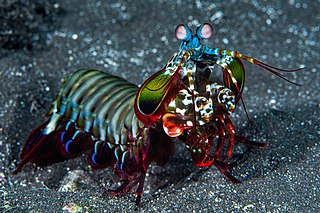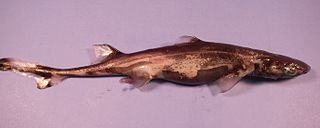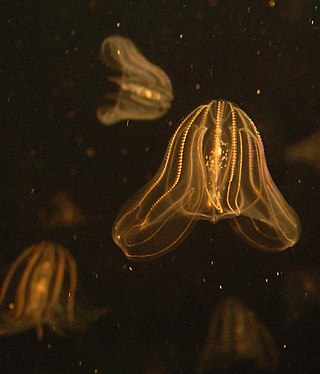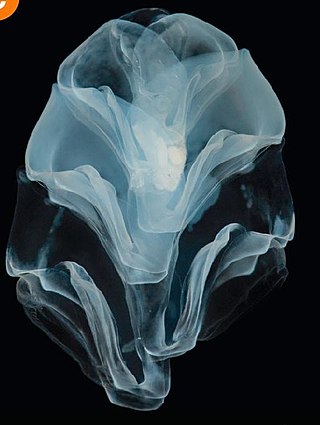
Parrotfish are a group of fish species traditionally regarded as a family (Scaridae), but now often treated as a subfamily (Scarinae) or tribe (Scarini) of the wrasses (Labridae). With roughly 95 species, this group's largest species richness is in the Indo-Pacific. They are found in coral reefs, rocky coasts, and seagrass beds, and can play a significant role in bioerosion.

Odontodactylus is a genus of mantis shrimp, the only genus in the family Odontodactylidae. Mantis shrimp of the genus Odontodactylus can not only detect circular polarisation of light, but can also detect polarised light reflecting off their telson and uropods.

Cakile is a genus within the flowering plant family Brassicaceae. Species in this genus are commonly known as searockets, though this name on its own is applied particularly to whatever member of the species is native or most common in the region concerned, the European searocket Cakile maritima in Europe, and the American searocket C. edentula in North America. The genus is native to Europe, Asia and North America, but the European searocket has been introduced into North America and has spread widely on both east and west coasts; in many places it is replacing the native C. edentula, and is regarded as an undesirable invasive species.

The cusk-eel family, Ophidiidae, is a group of marine bony fishes in the Ophidiiformes order. The scientific name is from the Greek ophis meaning "snake", and refers to their eel-like appearance. True eels diverged from other ray-finned fish during the Jurassic, while cusk-eels are part of the Percomorpha clade, along with tuna, perch, seahorses and others.

Somniosus is a widely distributed genus of deepwater dogfish sharks in the family Somniosidae. Several members of the genus are believed to attain lengths up to 7 m (23 ft), thus ranking among the largest of sharks.

Etmopterus is a genus of lantern sharks in the squaliform family Etmopteridae. They are found in deep sea ecosystems of the Atlantic, Indian and Pacific Oceans.

Utricularia resupinata, popularly known as lavender bladderwort or northeastern bladderwort, is a small perennial subaquatic carnivorous plant that belongs to the genus Utricularia. It is native to eastern Canada, the United States, and Central America. This plant species has an interesting etymology, growth pattern, ecology, and research history. As a plant that is threatened or endangered in many of the States where it is found, it is a candidate for sound conservation efforts.

Squilla is a genus of mantis shrimp. It includes the following species:

Orson Knapp Miller Jr. was an American mycologist. He published numerous papers in mycology and was responsible for the naming of many taxa, as well as being one of the authors erecting the genus Chroogomphus. He described Omphalotus olivascens, several species of Amanita, and the ghoul fungus Hebeloma aminophilum.
Howard Elson Bigelow was an American mycologist, born in 1923 in Greenfield, Massachusetts, and died in 1987. He studied at Oberlin College from 1941 to 1943. He left college to fight in the American army. He returned to Oberlin after the war and obtained his Bachelor of Arts in 1949 and his Master of Arts in 1951. He studied botany at the University of Michigan under the guidance of Alexander Hanchett Smith (1904–1986) and received his doctorate in 1956. He was wed to mycologist Margaret Elizabeth Barr-Bigelow in 1956. Bigelow and his wife worked for University of Massachusetts from 1957 to his death. He is the author of works on the fungi of the genus Clitocybe and the family Tricholomataceae.

Bolinopsidae is a family of ctenophores.
The genus Eridacnis, the ribbontail catsharks, is a small genus of fin-back catsharks in the family Proscylliidae. It currently consists of the following species:

Prayidae is a family of marine invertebrates in the order Siphonophorae. They are colonial, and the colonies can superficially resemble jellyfish; although they appear to be a single organism, each specimen is actually a colony of Siphonophora.

Limnomedusae is an order of hydrozoans.

Olindiidae is a family of hydrozoans in the order Limnomedusae. They have a polyp phase and a medusa phase. The polyps are generally small (1 mm) and solitary, but a few species are colonial. They have a varying number of tentacles and can reproduce by budding. In the largest species, the medusae can grow to 15 cm (6 in). Centripetal canals may be present or absent and the radial canals are unbranched. The gonads are beside the radial canals, except in Limnocnida, where they are on the manubrium. The fertilised eggs develop into planula larvae which become polyps. These multiply asexually or can bud off medusae. In some species, medusae are only produced when the water temperature exceeds a certain level. Most species are marine, but several can also be found in brackish water and a few, notably Craspedacusta and Limnocnida, are found in fresh water.

Cassiopea xamachana, commonly known as the upside-down jellyfish, is a species of jellyfish in the family Cassiopeidae. It is found in warm parts of the western Atlantic Ocean, the Caribbean Sea, and the Gulf of Mexico. It was first described by the American marine biologist Henry Bryant Bigelow in 1892.

The Diphyidae are a family of siphonophores. These are colonial siphonophores with two nectophores arranged one behind the other. The front one includes a somatocyst, while the hind one does not. The somatocyst often contains an oil droplet for buoyancy control. A nectosac in each nectophore allows the organism to swim efficiently.

Atorella is a genus of crown jellyfish. It is the only genus in the monotypic family Atorellidae and includes five species. Members of this family are known from the eastern coast of Africa and the western coast of Panama.

Hippopodius is a genus of cnidarians belonging to the family Hippopodiidae.
Nauarchus is a genus of freshwater hydrozoans in the family Olindiidae. Like all members of that family, they have a polyp phase and a medusa phase. The genus is monotypic, including only the species Nauarchus halius.















